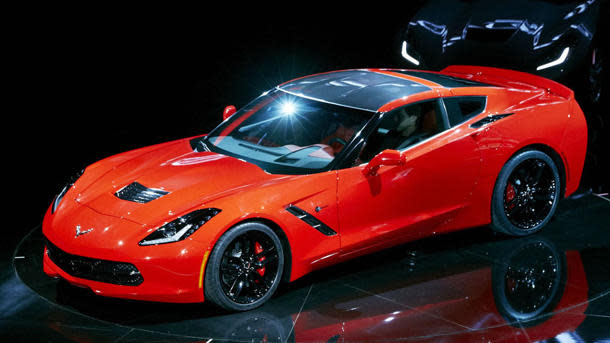 Motoramic
MotoramicThe 2014 Chevrolet Corvette Stingray arrives with edges sharpened

In a rational world, the 2014 Chevrolet Corvette Stingray wouldn’t exist. The very idea of launching a two-seat sports car named after a World War II ship powered by a truck-sized V-8 goes against every trend line on every chart in every automaker’s boardroom. Yet here it is, the seventh generation of America’s most venerated sports car, sharpened in all dimensions by racing experience toward out-hustling the best sports cars in the world. The question will be whether it can outrun history.
After 60 years of production, General Motors could have found ample reasons for waving the checkered flag at the Vette. Thanks to GM’s bankruptcy, the Vette has soldiered on longer than it should have without a major update; GM sold 14,132 last year, well off the 30,000 a year it sustained for much of the past decade. New U.S. fuel economy rules hit sports cars head-on, demanding the same measure of efficiency improvements in hot rods as in compact family sedans.
More importantly, the Corvette has lost much of its cultural currency from the heyday of NASA astronauts drag-racing their free Corvettes on the beach, falling into the tar pit of an old man’s car competing for young people’s attention. From “Transformers” to the “Fast and Furious” movies, Hollywood prefers the new Chevy Camaro and those Vettes the astronauts drove. A survey from the popular Forza racing video game of the most-driven models found the modern Vette didn’t crack the top 40. And while you can still buy Barbie her classic pink Vette, it’s a far less popular choice than sending her off with Ken in a Mini Cooper.
On first view, the makeover wrought by Corvette chief engineer Tadge Juechter and team appears evolutionary. Yet every piece of the car has either been re-engineered or updated, from the new all-aluminum frame to the sharper, “shrink-wrapped” exterior to the 6.2-liter, 450-hp, 450 lb.-ft. V-8. That engine can now be paired to an optional Tremec 7-speed manual, a GM first, that will automatically match the engine’s RPMs to the anticipated gear in all shifts.
The biggest improvements come from applying modern electronic controls throughout the car for the first time. The Corvette will have five driving modes that alter 12 different systems, from the optional electronic limited-slip differential that’s part of the Z51 track package to launch control. In “eco” mode, the all-new V-8 will shut off four cylinders for maximum fuel economy, while in “track” mode, Chevy engineers say the new Vette will pull more than 1 g of cornering force and run to 60 mph in less than 4 seconds. (Chevy vows to release exact figures, including prices, closer to the car's launch this fall.)
The interior, long the weakest part of the car, has been renovated to modern sports car standards. In place of Barbie-quality plastic, the dash comes wrapped in leather and carbon fiber; the heated and cooled seats have bolstering built for track use. The Vette also finally gets the requisite HD LED screens for the center console, but Chevy wisely keeps separate radio and air control switches instead of touch screen controls.
Much of the Vette’s improvements began as lessons learned from the Le Mans-winning Vette C6.R endurance racing team, such as the new fender intakes by the rear window that cool the transmission and differential. Purists have already begun to exclaim over the loss of the Vette’s trademark round taillights; the new squarish units take that shape because their frames double as a cooling vents.
While Corvette enthusiasts often dream of more radical changes, the Corvette engineering team has six decades of experience arguing against such moves. Moving to a smaller V-8 or turbocharged V-6 as in the Nissan GT-R would have added more weight while doing little for fuel economy; Chevy expects the new model to easily surpass the previous generation’s 26 mpg highway rating. A mid-engine super Vette would lose the sizable hatchback space that makes it more livable as an everyday car or grand tourer than a Porsche 911. And the unique suspension, with its transverse leaf spring rear axle, sacrifices little on the track while weighing less than the alternatives.
Some compromises were inevitable. Even with a new carbon-fiber roof and hood, and a frame that’s 99 lbs. lighter, the new Vette will weigh about as much as the old one, due to added pounds from the engine, interior bits and crash safety — although it keeps its perfect 50/50 front-rear weight balance and sports a lower center of gravity. The new 7-speed manual will still have a skip shift that forces higher gears for better city mileage, and a revised six-speed automatic remains standard.
But the greatest challenge for the new Stingray won't come from rivals like the new SRT Viper, the GT-R or the 911. As Zora Arkus-Duntov, the famed "father of the Corvette" wrote in 1954: "If the value of a car consists of practical values and emotional appeal, the sports car has very little of the first and consequently has to have an exaggerated amount of the second." The engineers behind the new Vette hope the revival of the Stingray name for the first time in 37 years along with years of knowledge gained from racing will spark that emotional connection with a new generation. The most apt answer for why the 2014 Corvette exists may be an Internet meme: Because racecar.
Top photo: Jim Fets


